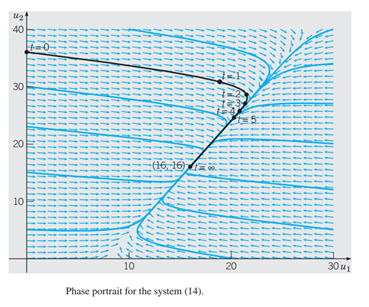Obtaining exact, or approximate, expressions for eigenvalues and eigenvectors in terms of the model parameters is often useful for understanding the qualitative behavior of solutions to a dynamical system. We illustrate using Example
1
in Section
3.2
.
(a) Show that the general solution of Eqs.
(
5
)
and
(
6
)
in section
3.2
can be represented as
u
=
c
1
x
1
(
t
)
+
c
2
x
2
(
t
)
+
u
^
(i)
where
u
^
is the equilibrium solution (see Problem
13
, Section
3.2
) to the system and
{
x
1
(
t
)
,
x
2
(
t
)
}
is a fundamental set of solutions to the homogeneous equation
x
'
=
(
−
(
k
1
+
k
2
)
k
2
ε
k
2
−
ε
k
2
)
x
=
K
x
(b) Assuming that
0
<
ε
≪
1
(i.e.,
ε
is positive and small relative to unity), show that approximations to the eigenvalues of
K
are
λ
1
(
ε
)
≅
−
(
k
1
+
k
2
)
−
ε
k
2
2
k
1
+
k
2
and
λ
2
(
ε
)
≅
−
ε
k
1
k
2
k
1
+
k
2
.
(c) Show that approximations to the corresponding eigenvectors are
v
1
(
ε
)
=
(
1
,
−
ε
k
2
/
(
k
1
+
k
2
)
)
T
and
v
2
(
ε
)
=
(
k
2
/
(
k
1
+
k
2
)
,
1
)
T
.
(d) Use the approximations obtained in parts (b) and (c) and the equilibrium solution
u
^
to write down an approximation to the general solution (i). Assuming that nominal values for
k
1
and
k
2
are near unity, and that
0
<
ε
≪
1
, sketch a qualitatively accurate phase portrait for Eqs.
(
5
)
and
(
6
)
in Section
3.2
. Compare your sketch with the phase portrait in Figure
3.2.4
, Section
3.2
.
(e) Show that when
t
is large and the system is in the quasi-steady state,
u
1
≅
k
1
k
1
+
k
2
T
a
+
k
2
k
1
+
k
2
u
2
,
u
2
≅
(
u
20
−
T
a
)
exp
(
−
ε
k
1
k
2
k
1
+
k
2
t
)
+
T
a
,
where
u
2
(
0
)
=
u
20
. Now let
ε
→
0
. Interpret the results. Compare with the results of Problem
14
in Section
3.2
.
(f) Give a physical explanation of the significance of the eigenvalues on the dynamical behavior of the solution
(i)
. In particular, relate the eigenvalues to fast and slow temporal changes in the state of the system. What implications does the value of
ε
have with respect to the design of the green-house/rockbed system? Explain, giving due consideration to local climatic conditions and construction costs.
Example
1
in Section
3.2
Consider the schematic diagram of the greenhouse/rockbed system in Figure
3.2.1
. The rockbed, consisting of rocks ranging in size from
2
to, is loosely packed so that air can easily pass through the void space between the rocks. The rockbed, and the underground portion of the air ducts used to circulate air through the system, are thermally insulated from the surrounding soil.
Rocks are a good material for storing heat since they have a high energy-storage capacity, are inexpensive, and have a long life.
d
u
1
d
t
=
−
(
k
1
+
k
2
)
u
1
+
k
2
u
2
+
k
1
T
a
,
(
5
)
d
u
2
d
t
=
ε
k
2
u
1
−
ε
k
2
u
2
,
(
6
)
u
=
(
u
1
u
2
)
,
b
=
(
14
0
)
,
K
=
(
−
13
8
3
4
1
4
−
1
4
)
(
13
)
d
u
d
t
=
Ku
+
b
(
14
)
Using vector notation, the initial conditions are expressed as
u
(
0
)
=
u
0
=
(
u
10
u
20
)
(
15
)

Section
3.2
Find the equilibrium solution, or critical point, of Eqs.
(
5
)
and
(
6
)
of Example
1
.
d
u
1
d
t
=
−
(
k
1
+
k
2
)
u
1
+
k
2
u
2
+
k
1
T
a
(
5
)
d
u
2
d
t
=
ε
k
2
u
1
−
ε
k
2
u
2
(
6
)
In the limiting case,
ε
→
0
, Eqs.
(
5
)
and
(
6
)
of Example
1
reduce to the partially coupled system
d
u
1
d
t
=
−
(
k
1
+
k
2
)
u
1
+
k
2
u
2
+
k
1
T
a
(
5
)
d
u
2
d
t
=
ε
k
2
u
1
−
ε
k
2
u
2
(
6
)
d
u
1
d
t
=
−
(
k
1
+
k
2
)
u
1
+
k
2
u
2
+
k
1
T
a
,
(
i
)
d
u
2
d
t
=
0
.
(
i
i
)
Thus, if initial conditions
u
1
(
0
)
=
u
10
and
u
2
(
0
)
=
u
20
are prescribed, Eq.
(
i
i
)
implies that
u
2
(
t
)
=
u
20
for all
t
≥
0
. Therefore Eq.
(
i
)
reduces to a first order equation with one dependent variable,
d
u
1
d
t
=
−
(
k
1
+
k
2
)
u
1
+
k
2
u
20
+
k
1
T
a
.
(
i
i
i
)
(
a
)
Find the critical point (equilibrium solution) of Eq.
(
i
i
i
)
and classify it as asymptotically stable or unstable. Then draw the phase line, and sketch several graphs of solutions in the
t
u
1
−
p
l
a
n
e
.
(
b
)
Find the solution of Eq.
(
i
i
i
)
subject to the initial condition
u
1
(
0
)
=
u
10
and use it to verify the qualitative results of part
(
a
)
.
(
c
)
What is the physical interpretation of setting
ε
=
0
? Give a physical interpretation of the equilibrium solution found in part
(
a
)
.
(
d
)
What do these qualitative results imply about the sizing of the rock storage pile in combination with temperatures that can be achieved in the rock storage pile during the daytime?



 Calculus For The Life SciencesCalculusISBN:9780321964038Author:GREENWELL, Raymond N., RITCHEY, Nathan P., Lial, Margaret L.Publisher:Pearson Addison Wesley,
Calculus For The Life SciencesCalculusISBN:9780321964038Author:GREENWELL, Raymond N., RITCHEY, Nathan P., Lial, Margaret L.Publisher:Pearson Addison Wesley, Elementary Linear Algebra (MindTap Course List)AlgebraISBN:9781305658004Author:Ron LarsonPublisher:Cengage Learning
Elementary Linear Algebra (MindTap Course List)AlgebraISBN:9781305658004Author:Ron LarsonPublisher:Cengage Learning Linear Algebra: A Modern IntroductionAlgebraISBN:9781285463247Author:David PoolePublisher:Cengage Learning
Linear Algebra: A Modern IntroductionAlgebraISBN:9781285463247Author:David PoolePublisher:Cengage Learning


